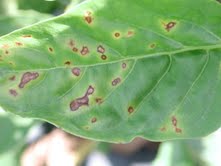Bacterial Spot of Pepper and Tomato


The center of the lesion often dies and collapses. As a rule the spots do not merge. On older leaves of plants in the field, the lesions are usually dark green, water-soaked, not noticeably raised, and up to 1/8 or 1/4 inch in diameter. Later, these spots develop dead, pale yellow centers with dark brown borders (Figure1). When numerous, the lesions remain dark brown with a paler brown center on the lower leaf surface. Spotted leaves may turn yellow and fall at any time during the season. When spots are numerous, entire leaves drop off while still green. Seedlings infected in the plant bed may lose all but their top leaves.
First thing I thought of, the description is similar but every image I find leads me elsewhere.
Symptoms started (were noticed) 2 days ago, the morning after spraying with soap/mineral oil. I've sprayed all stages of plants with this before, and had no ill effect. It started out with small appearances of the brown stain/spot, doesn't respond to rubbing/wiping, and by that night developed chlorotic spots. Upper foliage is most effected. Last night I sprayed H202 to help (hopefully) stem the spread and will continue this until I can determine a cause/solution.




Getting no results from Google/THP searches. Am I special, as in, "Wow, never seen that before" or the pat on the head special, where I've clearly missed the boat, and this is quite simple?


The center of the lesion often dies and collapses. As a rule the spots do not merge. On older leaves of plants in the field, the lesions are usually dark green, water-soaked, not noticeably raised, and up to 1/8 or 1/4 inch in diameter. Later, these spots develop dead, pale yellow centers with dark brown borders (Figure1). When numerous, the lesions remain dark brown with a paler brown center on the lower leaf surface. Spotted leaves may turn yellow and fall at any time during the season. When spots are numerous, entire leaves drop off while still green. Seedlings infected in the plant bed may lose all but their top leaves.
First thing I thought of, the description is similar but every image I find leads me elsewhere.
Symptoms started (were noticed) 2 days ago, the morning after spraying with soap/mineral oil. I've sprayed all stages of plants with this before, and had no ill effect. It started out with small appearances of the brown stain/spot, doesn't respond to rubbing/wiping, and by that night developed chlorotic spots. Upper foliage is most effected. Last night I sprayed H202 to help (hopefully) stem the spread and will continue this until I can determine a cause/solution.




Getting no results from Google/THP searches. Am I special, as in, "Wow, never seen that before" or the pat on the head special, where I've clearly missed the boat, and this is quite simple?

